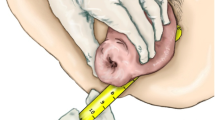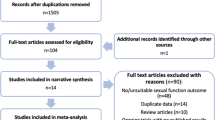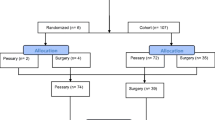Abstract
Introduction and hypothesis
The purpose of this systematic review is to assess the impact of pessary use on the quality of life of women with pelvic organ prolapse, and to determine the satisfaction rate and rationale for discontinuation.
Methods
This review is recorded in the PROSPERO database under number CRD42015023384. The criteria for inclusion were observational study; cross section; cohort study; randomized controlled trial; study published in English, Portuguese, and Spanish; and study whose participants are women with female pelvic organ prolapse treated using a pessary. We did not include limitations on the year of publication. The criteria for exclusion included studies that did not include the topic, bibliographic or systematic reviews and articles that did not use validated questionnaires. The MeSH terms were “Pelvic Organ Prolapse AND Pessaries AND Quality of Life” OR “Pessary AND Quality of Life” OR “Pessaries”.
Results
We found 89 articles. After the final analyses, seven articles were included. All articles associated pessary use with improved quality of life, and all used only validated questionnaires. Over half of the women continued using the pessary during the follow-up with acceptable levels of satisfaction. The main rationales for discontinuation were discomfort, pain in the area, and expulsion of the device.
Conclusion
This systematic review demonstrates that the pessary can produce a positive effect on women’s quality of life and can significantly improve sexual function and body perception.

Similar content being viewed by others
References
Haylen BT, de Ridder D, Freeman RM, Swift SE, Berghmans B, Lee J et al (2010) An International Urogynecological Association (IUGA)/International Continence Society (ICS) joint report on the terminology for female pelvic floor dysfunction. Int Urogynecol J 21(1):5–26
Digesu GA, Khullar V, Cardozo L, Robinson D, Salvatore S (2005) P-QOL: a validated questionnaire to assess the symptoms and quality of life of women with urogenital prolapse. Int Urogynecol J Pelvic Floor Dysfunct 16(3):176–181, discussion 81
Luber KM, Boero S, Choe JY (2001) The demographics of pelvic floor disorders: current observations and future projections. Am J Obstet Gynecol 184(7):1496–1501, discussion 501–503
Wiskind AK, Creighton SM, Stanton SL (1992) The incidence of genital prolapse after the Burch colposuspension. Am J Obstet Gynecol 167(2):399–404, discussion 405
Kjølhede P, Norén B, Rydén G (1996) Prediction of genital prolapse after Burch colposuspension. Acta Obstet Gynecol Scand 75(9):849–854
Braekken IH, Majida M, Engh ME, Bø K (2010) Can pelvic floor muscle training reverse pelvic organ prolapse and reduce prolapse symptoms? An assessor-blinded, randomized, controlled trial. Am J Obstet Gynecol 203(2):170.e1–170.e7
McIntosh L (2005) The role of the nurse in the use of vaginal pessaries to treat pelvic organ prolapse and/or urinary incontinence: a literature review. Urol Nurs 25(1):41–48
Tegerstedt G, Maehle-Schmidt M, Nyrén O, Hammarström M (2005) Prevalence of symptomatic pelvic organ prolapse in a Swedish population. Int Urogynecol J Pelvic Floor Dysfunct 16(6):497–503
Woodman PJ, Swift SE, O’Boyle AL, Valley MT, Bland DR, Kahn MA et al (2006) Prevalence of severe pelvic organ prolapse in relation to job description and socioeconomic status: a multicenter cross-sectional study. Int Urogynecol J Pelvic Floor Dysfunct 17(4):340–345
Manchana T (2011) Ring pessary for all pelvic organ prolapse. Arch Gynecol Obstet 284(2):391–395
Mutone MF, Terry C, Hale DS, Benson JT (2005) Factors which influence the short-term success of pessary management of pelvic organ prolapse. Am J Obstet Gynecol 193(1):89–94
Lamers BH, Broekman BM, Milani AL (2011) Pessary treatment for pelvic organ prolapse and health-related quality of life: a review. Int Urogynecol J 22(6):637–644
Hutton B, Salanti G, Caldwell DM, Chaimani A, Schmid CH, Cameron C et al (2015) The PRISMA extension statement for reporting of systematic reviews incorporating network meta-analyses of health care interventions: checklist and explanations. Ann Intern Med 162(11):777–784
Whiting P, Savović J, Higgins JP, Caldwell DM, Reeves BC, Shea B et al (2016) ROBIS: a new tool to assess risk of bias in systematic reviews was developed. J Clin Epidemiol 69:225–234
Patel M, Mellen C, O’Sullivan DM, LaSala CA (2010) Impact of pessary use on prolapse symptoms, quality of life, and body image. Am J Obstet Gynecol 202(5):499.e1–499.e4
Mamik MM, Rogers RG, Qualls CR, Komesu YM (2013) Goal attainment after treatment in patients with symptomatic pelvic organ prolapse. Am J Obstet Gynecol 209(5):488.e1–488.e5
Kuhn A, Bapst D, Stadlmayr W, Vits K, Mueller MD (2009) Sexual and organ function in patients with symptomatic prolapse: are pessaries helpful? Fertil Steril 91(5):1914–1918
Cundiff GW, Amundsen CL, Bent AE, Coates KW, Schaffer JI, Strohbehn K et al (2007) The PESSRI study: symptom relief outcomes of a randomized crossover trial of the ring and Gellhorn pessaries. Am J Obstet Gynecol 196(4):405.e1–405.e8
Komesu YM, Rogers RG, Rode MA, Craig EC, Gallegos KA, Montoya AR et al (2007) Pelvic floor symptom changes in pessary users. Am J Obstet Gynecol 197(6):620.e1–620.e6
Abdool Z, Thakar R, Sultan AH, Oliver RS (2011) Prospective evaluation of outcome of vaginal pessaries versus surgery in women with symptomatic pelvic organ prolapse. Int Urogynecol J 22(3):273–278
Lone F, Thakar R, Sultan AH (2015) One-year prospective comparison of vaginal pessaries and surgery for pelvic organ prolapse using the validated ICIQ-VS and ICIQ-UI (SF) questionnaires. Int Urogynecol J 26(9):1305–1312
Fernando RJ, Thakar R, Sultan AH, Shah SM, Jones PW (2006) Effect of vaginal pessaries on symptoms associated with pelvic organ prolapse. Obstet Gynecol 108(1):93–99
Chan SS, Cheung RY, Yiu KW, Lee LL, Pang AW, Chung TK (2012) Symptoms, quality of life, and factors affecting women’s treatment decisions regarding pelvic organ prolapse. Int Urogynecol J 23(8):1027–1033
Kapoor DS, Freeman RM (2009) Reoperation rate following prolapse surgery. Am J Obstet Gynecol 200(2):e15, author reply e15
Bash KL (2000) Review of vaginal pessaries. Obstet Gynecol Surv 55(7):455–460
Clemons JL, Aguilar VC, Tillinghast TA, Jackson ND, Myers DL (2004) Patient satisfaction and changes in prolapse and urinary symptoms in women who were fitted successfully with a pessary for pelvic organ prolapse. Am J Obstet Gynecol 190(4):1025–1029
Maito JM, Quam ZA, Craig E, Danner KA, Rogers RG (2006) Predictors of successful pessary fitting and continued use in a nurse-midwifery pessary clinic. J Midwifery Womens Health 51(2):78–84
Robert M, Schulz JA, Harvey MA, Lovatsis D, Walter JE, Chou Q et al (2013) Technical update on pessary use. J Obstet Gynaecol Can 35(7):664–674
Author information
Authors and Affiliations
Corresponding author
Ethics declarations
Conficts of interest
None.
Rights and permissions
About this article
Cite this article
de Albuquerque Coelho, S.C., de Castro, E.B. & Juliato, C.R.T. Female pelvic organ prolapse using pessaries: systematic review. Int Urogynecol J 27, 1797–1803 (2016). https://doi.org/10.1007/s00192-016-2991-y
Received:
Accepted:
Published:
Issue Date:
DOI: https://doi.org/10.1007/s00192-016-2991-y




